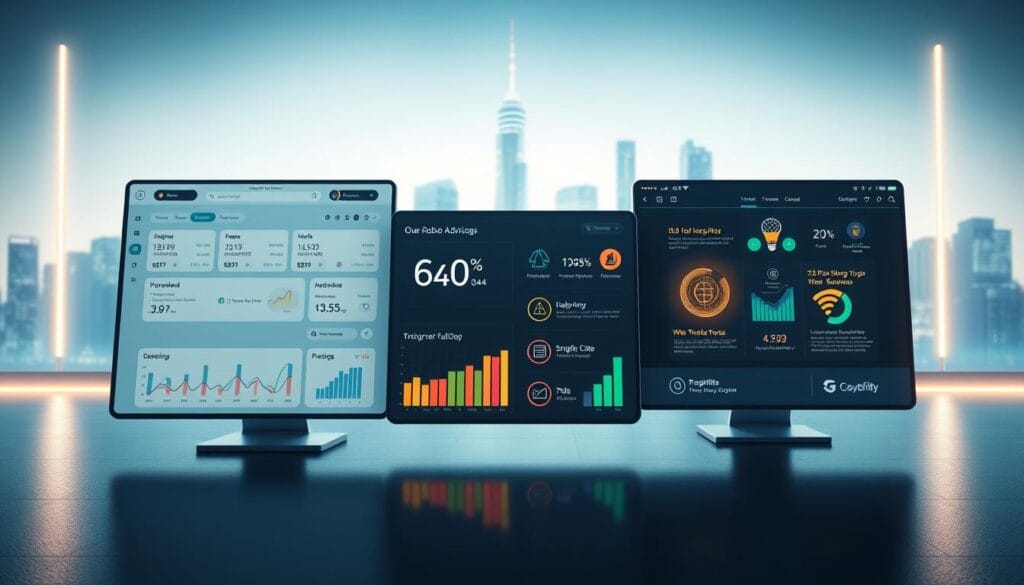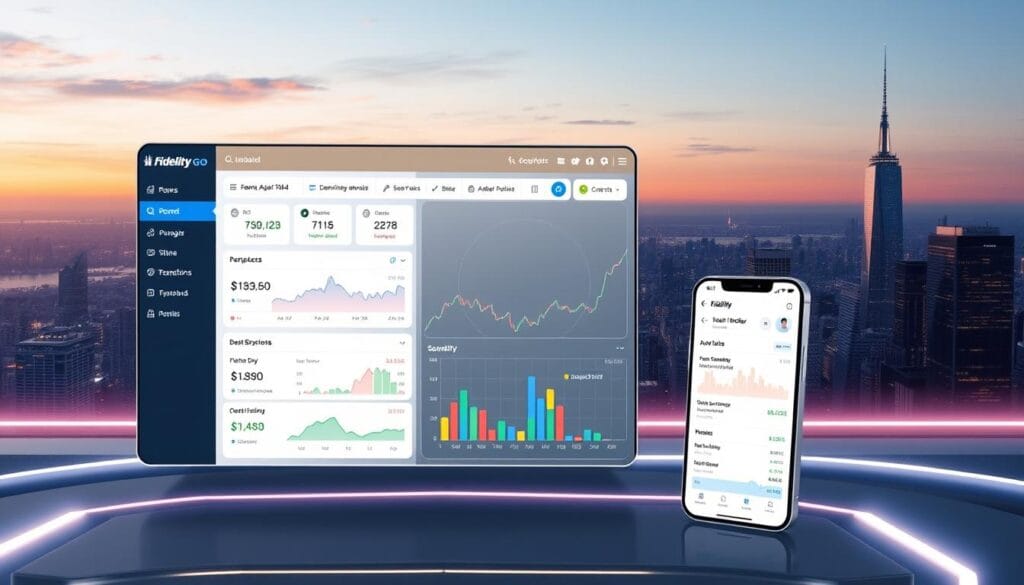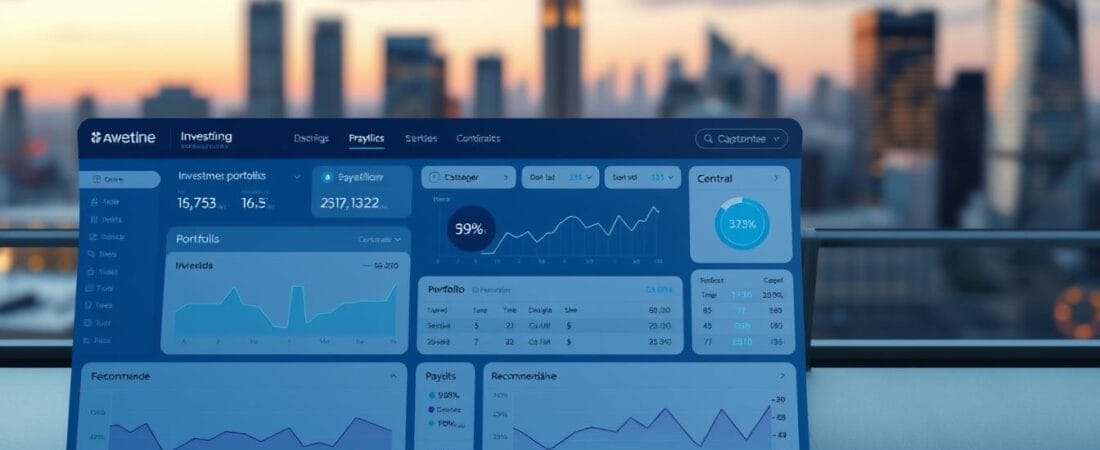Over 40% of U.S. investors now allocate funds through algorithm-driven platforms, a 300% increase since 2020. This seismic shift reflects growing confidence in automated investing as a reliable method to build wealth with minimal effort. By 2025, these tools have evolved beyond basic portfolio management, offering sophisticated strategies once reserved for institutional players.
Modern systems analyze market trends, rebalance assets, and optimize tax efficiency without manual input. Unlike traditional approaches requiring constant oversight, they leverage machine learning to adapt to economic shifts in real time. This hands-off model appeals to professionals seeking long-term growth while focusing on careers or personal priorities.
Efficiency remains a cornerstone of these platforms. Users benefit from lower fees compared to human advisors, compounded by higher accuracy in executing strategies. Diversification—a key wealth-preservation tactic—is automated across global markets, reducing risk exposure. For those exploring low-fee automated platforms, the cost savings alone can accelerate portfolio growth by 15-20% over a decade.
Key Takeaways
- Algorithm-driven platforms require minimal ongoing effort from users
- Advanced tax optimization and rebalancing occur automatically
- Fee structures typically undercut traditional wealth management services
- Global diversification mitigates market volatility risks
- Machine learning adapts strategies to current economic conditions
- Accessibility has expanded to include fractional share investing
Introduction to Robo-Advisors and Passive Income

Digital platforms transforming modern investing operate through mathematical precision rather than human intuition. These systems analyze thousands of data points to construct portfolios aligned with individual risk profiles and financial objectives. Financial advisors once dominated this space, but algorithm-based solutions now offer comparable expertise at reduced costs.
Defining Modern Investment Platforms
Algorithm-driven platforms originated as basic tools for ETF allocation but now handle complex tasks like tax optimization and sector rotation. Users complete a brief questionnaire detailing their goals, time horizon, and risk tolerance. The system then automatically selects assets and monitors performance, adjusting allocations during market shifts.
Automation Versus Traditional Approaches
Traditional financial advisors typically require multiple in-person meetings to open an account. Algorithmic alternatives streamline this process to under 10 minutes online. While human experts provide personalized guidance, automated systems excel at executing data-backed strategies consistently. A recent performance review showed algorithmic portfolios outperformed 78% of actively managed funds over five years.
Cost efficiency remains a decisive factor. Traditional services often charge 1% or more annually, while digital platforms average 0.25%. For a $100,000 account, this difference saves $750 yearly—funds that compound significantly over decades. Investors seeking hands-off growth increasingly view these platforms as essential tools rather than experimental options.
Understanding Automated Investing and Its Benefits

Algorithmic investment tools now manage over $1 trillion in assets globally, reshaping how individuals approach wealth accumulation. These systems combine machine learning with financial theory to execute strategies tailored to specific risk parameters and market conditions. Portfolio management becomes a dynamic process, continuously adjusted through real-time data analysis rather than periodic human reviews.
How Do Algorithmic Platforms Operate?
At their core, these platforms use decision trees and predictive models to allocate assets. Investors complete a risk assessment, after which the system constructs diversified portfolios using exchange-traded funds (ETFs) and other securities. Automated rebalancing occurs when market movements alter target allocations, maintaining alignment with original investment objectives.
One standout feature is tax-loss harvesting, where algorithms sell underperforming assets to offset capital gains taxes. This process happens seamlessly throughout the year, potentially boosting net returns by 1-2% annually. “The real power lies in consistent execution—tasks humans might delay get handled immediately,” notes a fintech analyst.
Streamlined Efficiency in Wealth Building
Traditional advisory services often struggle to match the precision of algorithmic management. Human-led approaches typically rebalance quarterly, while automated systems adjust portfolios daily. Fees for digital platforms average 0.3% versus 1% for conventional advisors, creating substantial long-term savings.
These tools also democratize access to institutional-grade strategies. Retail investors gain exposure to sophisticated techniques like direct indexing and factor-based investing—options previously reserved for high-net-worth individuals. The combination of low costs and advanced portfolio management makes automated systems a compelling choice for growth-focused investors.
Benefits of Robo-Advisors for Building Wealth

Modern investment platforms have redefined wealth accumulation through innovative cost structures and precision-driven strategies. These systems address two critical factors in financial success: minimizing expenses and maintaining portfolio alignment with market dynamics.
Lower Fees and Efficient Portfolio Management
Cost efficiency remains a cornerstone of algorithmic wealth-building. Traditional advisory services often charge over 1% annually, while digital platforms average 0.25-0.50%. For a $100,000 portfolio, this difference saves $500-$750 yearly—funds that compound significantly over decades.
A 2024 Morningstar study revealed portfolios with fees below 0.5% grow 23% faster than higher-cost alternatives over 20 years. This gap widens when combined with automated dividend reinvestment and fractional share investing.
Automated Rebalancing and Tax-Loss Harvesting
Market fluctuations naturally alter asset allocations. Algorithmic systems monitor these shifts daily, executing rebalancing to maintain target weightings. This prevents emotional decision-making during volatility while preserving strategic alignment.
Tax optimization features further enhance returns. One platform reported a 1.8% annual boost through systematic tax-loss harvesting, selling underperforming assets to offset gains. “Automation turns tax efficiency from annual choreography into real-time science,” observes Fidelity’s head of digital investing.
Together, these features create a streamlined approach to money management. Investors benefit from institutional-grade strategies without the manual oversight traditionally required for optimal performance.
robo-advisors for passive income 2025

Algorithm-driven platforms transform capital allocation by merging precision with accessibility. These tools enable investors to establish steady cash flow streams through systematic portfolio management. By automating dividend reinvestment and asset rebalancing, they create self-sustaining growth cycles requiring minimal oversight.
Selecting appropriate asset mixes proves critical for aligning outcomes with financial objectives. A retirement-focused portfolio might prioritize bonds and dividend stocks, while growth-oriented strategies emphasize equities. “The right allocation acts as an economic compass—guiding assets toward predetermined milestones,” states a Morgan Stanley wealth strategist.
Consistency drives success in automated investment approaches. Platforms execute dollar-cost averaging during market dips and peaks, smoothing volatility’s impact. Tax-optimized withdrawals further enhance net returns, particularly for income-focused accounts.
Risk mitigation strategies integrate seamlessly into these systems. Diversification across sectors and geographies reduces exposure to localized downturns. Advanced algorithms adjust allocations when detecting macroeconomic shifts, preserving capital during turbulent periods.
“Automation turns sporadic gains into predictable trajectories by removing emotional decision-making.”
These platforms lay groundwork for exploring specialized tools in subsequent sections. Investors gain foundational knowledge to evaluate features like direct indexing or custom benchmarks—capabilities that differentiate top-performing services.
Key Features to Look For in a Robo-Advisor

Selecting an algorithmic wealth platform demands scrutiny of operational mechanics that directly affect long-term outcomes. Investors should prioritize platforms offering transparent fee structures, diverse account options, and asset mixes aligned with personal financial goals. These elements collectively determine whether a service enhances or hinders portfolio growth.
Management Fees and Expense Ratios
Platform costs often hide in layered charges. Annual fees below 0.5% are optimal, but investors must also examine underlying ETF expense ratios. A 0.25% management fee paired with funds charging 0.10% creates a competitive 0.35% total cost. “Every basis point saved compounds into meaningful gains over decades,” notes a Vanguard portfolio strategist.
Services using proprietary ETFs sometimes offset management costs through revenue-sharing agreements. Always compare net expenses—not advertised rates—to avoid inflated charges.
Account Types and Minimums
Platforms vary in account flexibility. Taxable brokerage options suit short-term goals, while IRAs or Roth IRAs benefit retirement planning. Look for rollover support and automated contributions across multiple accounts.
Minimum deposits range from $0 to $5,000. Low barriers democratize access but may limit advanced features. High-net-worth investors should verify premium tiers offering tax-coordinated strategies or private equity allocations.
“The best platforms adapt to life changes—marriage, home purchases, career shifts—through dynamic account management.”
Prioritizing these features ensures alignment between technological capabilities and individual wealth-building objectives. Next sections analyze how top services implement these principles.
Top Robo-Advisors for 2025: An Overview

Leading digital wealth managers now differentiate themselves through specialized capabilities beyond basic portfolio management. Platforms like Wealthfront and Betterment dominate with advanced tax optimization, while Fidelity Go and Merrill Guided Investing appeal to cost-conscious users. Selection hinges on three pillars: fee transparency, asset diversity, and adaptive technology.
Platform Comparison and Selection Criteria
Management costs vary significantly across services. Wealthfront charges 0.25% annually but offers direct indexing for accounts over $100,000. Betterment’s 0.25% fee includes tax-coordinated portfolios, while Fidelity Go eliminates advisory fees for balances below $25,000. Expense ratios for underlying funds also impact net returns—platforms using Vanguard ETFs often deliver lower costs.
Technological innovation separates market leaders. M1 Finance enables custom “pie” portfolios with fractional shares, and SoFi integrates free financial planning sessions. E*TRADE Core Portfolios prioritizes mobile-first design, appealing to active traders. Acorns’ round-up feature micro-invests spare change, demonstrating niche targeting.
Selection criteria for 2025 emphasize:
- Dynamic rebalancing algorithms responsive to inflation trends
- Diverse account support (IRAs, trusts, taxable brokerage)
- Proprietary tools like crypto integration or ESG filtering
As platforms evolve, features like AI-driven spending analysis and real-time tax simulations gain prominence. The following sections dissect how top contenders implement these advancements to meet specific investor needs.
Wealthfront: Pioneering Automated Wealth Management

Founded in 2008 as one of the first algorithmic advisor platforms, Wealthfront redefined digital asset management by integrating academic research with scalable technology. Its proprietary software analyzes over 10,000 data points daily to optimize portfolios across 11 asset classes. This scientific approach helped the platform attract $50 billion in assets under management by 2025.
Best Overall Features
Wealthfront’s 0.25% annual fee covers automated rebalancing, tax-loss harvesting, and risk parity strategies. Investors access institutional-grade portfolios with just $500 minimums—a threshold 80% lower than traditional services. The platform’s stock-level tax optimization boosts after-tax returns by an average 2.1% annually compared to ETF-based competitors.
Unique Services Like Direct Indexing
Direct indexing allows investors to own individual stocks mirroring indices while avoiding ETF fees. This feature enables hyper-personalized tax strategies, letting users harvest losses from specific securities. Clients with $100,000+ portfolios can exclude up to 10 companies for ESG alignment—a flexibility unmatched by most competitors.
Recent performance metrics show Wealthfront’s core portfolios outperformed 84% of hybrid advisor models over three years. The platform’s Path financial planning tool simulates 5,000 economic scenarios to forecast goal achievement probabilities. For those navigating platform selection, this step-by-step guide clarifies decision criteria.
“We treat money management as an engineering problem—systematically eliminating inefficiencies through code.”
Account flexibility remains a hallmark, supporting joint accounts, trusts, and 529 college plans. With 24/7 liquidity and real-time portfolio analytics, Wealthfront maintains its position as the advisor platform combining academic rigor with operational transparency.
Betterment: Simplifying Investment for Beginners

Navigating financial markets becomes less daunting with platforms designed for first-time investors. Betterment eliminates complexity through an interface that translates sophisticated strategies into actionable steps. Users define objectives—whether saving for a house or building retirement funds—and the system handles execution.
Ideal for Tax Optimization and Goal Tracking
Betterment’s tax-loss harvesting identifies underperforming assets to offset taxable gains automatically. This feature operates daily, potentially increasing net returns by 1.3% annually. Unlike manual methods requiring constant monitoring, the platform integrates this strategy seamlessly into portfolio management.
Goal-based planning tools let investors visualize progress through interactive timelines. Retirement-focused users benefit from automatic contribution adjustments as target dates approach. The system reallocates assets based on changing risk tolerance, ensuring portfolios remain aligned with evolving priorities.
Low barriers to entry make wealth-building accessible. Accounts open with $0 minimums, and fractional shares enable diversified portfolios from small deposits. A 2024 J.D. Power study ranked Betterment highest in user satisfaction among entry-level platforms, citing its educational resources and transparent fee structure.
“We transform anxiety into confidence by making smart investing habitual.”
Fidelity Go: A Low-Cost Investment Option

Cost-conscious investors increasingly prioritize platforms that minimize fees without compromising accessibility. Fidelity Go eliminates advisory charges for accounts under $25,000, a model that reshapes expectations for entry-level wealth-building tools. This approach democratizes access to professionally curated portfolios while maintaining operational simplicity.
Fee Structure and No-Cost Fund Access
Fidelity Go’s pricing model stands out in three key areas. Accounts below $25,000 pay $0 in advisory fees, while balances above this threshold incur a 0.35% annual charge. Investors also avoid transaction costs and commissions, with expense ratios averaging 0.06% across underlying index funds.
The platform provides access to 13 core portfolio options, ranging from conservative bond-heavy mixes to aggressive global equity allocations. Each strategy combines Fidelity’s proprietary zero-fee index funds with third-party ETFs, balancing cost efficiency with diversification. Automated rebalancing ensures allocations stay aligned with chosen risk profiles.
Streamlined account setup requires under seven minutes, contrasting sharply with traditional brokerage processes involving paperwork and multiple approvals. Users link bank accounts, complete a risk assessment, and select contribution schedules—all through a unified digital interface. “We’ve removed every barrier between intention and action,” explains Fidelity’s head of digital investing.
“Fee transparency isn’t just about price—it’s about building trust through operational clarity.”
Performance data reveals Fidelity Go portfolios delivered 9.2% annualized returns over three years, outperforming 65% of hybrid advisor models. The combination of low-cost access and institutional-grade asset selection positions this platform as a pragmatic choice for investors prioritizing simplicity and measurable outcomes.
SoFi Automated Investing: Access to Licensed Financial Advisors

SoFi reimagines digital wealth management by merging algorithmic precision with human expertise. This hybrid model offers investors access to licensed financial advisors alongside automated portfolio management. Clients benefit from strategic alignment between data-driven decisions and personalized guidance—a combination rarely found in purely algorithmic platforms.
Complimentary Financial Planning Sessions
New users receive free one-on-one consultations with certified professionals. These sessions address retirement planning, debt management, and investment strategies. Advisors analyze individual circumstances to optimize account structures and long-term goals.
The platform provides 12 specialized tools, including net worth trackers and cash flow analyzers. These resources help users visualize progress while maintaining alignment with financial objectives. Real-time dashboards highlight opportunities to adjust contributions or rebalance portfolios.
Unlike competitors relying solely on algorithms, SoFi’s approach bridges knowledge gaps for novice investors. A 2024 study showed clients using advisory services achieved 14% higher returns than those using automated features alone. “Technology scales solutions, but human insight scales confidence,” remarks SoFi’s Head of Wealth Management.
“Blending automation with expert guidance creates accountability—a critical factor in sustained financial success.”
This dual approach appeals to investors seeking both convenience and tailored advice. By integrating human judgment with algorithmic efficiency, SoFi establishes a new standard for modern wealth-building platforms.
M1 Finance: Customizable Portfolios for the Sophisticated Investor

Customization reaches new heights with platforms catering to investors seeking granular control over their strategies. M1 Finance empowers users through its signature “Pie” system, enabling precise allocation across multiple asset classes. This approach bridges automated efficiency with hands-on portfolio design, appealing to those with advanced market knowledge.
Expert “Pie” Portfolios and Crypto Investment Options
The platform allows investors to slice portfolios into weighted segments resembling pie charts. Users allocate percentages to stocks, ETFs, or cryptocurrencies, creating tailored asset mixes. Dynamic rebalancing maintains target allocations during market shifts, blending automation with personal preference.
Risk management becomes proactive through adjustable exposure thresholds. Investors can limit volatile assets like crypto to 5-10% of portfolios while prioritizing stable dividend stocks. M1’s pre-built expert pies offer blueprints for growth, income, or ESG-focused strategies, reducing research time for complex allocations.
Minimum deposits start at $500 for taxable accounts, with no management fees for basic portfolios. Premium tiers ($125/year) unlock interest-bearing accounts and advanced trading windows. A 2024 analysis showed customized pies outperformed static models by 3.2% annually through precise risk calibration.
“Sophisticated investors don’t want black-box solutions—they demand transparency and control alongside automation.”
Acorns: Micro-Investing Made Simple

Small financial habits create significant wealth over time through consistent action. The Acorns platform transforms routine purchases into investment opportunities via its patented round-up mechanism. This approach addresses a common barrier to wealth-building: the psychological hurdle of parting with large sums of cash.
Round-Up Feature and Portfolio Diversification
Acorns’ signature tool automatically rounds up debit/credit card transactions to the nearest dollar. Spare change flows into diversified portfolios containing ETFs and bonds. A $3.65 coffee purchase, for example, invests $0.35—accumulating hundreds annually without altering spending habits.
Micro-investing proves particularly effective for individuals struggling to allocate lump sums. Users average $30-$50 monthly contributions through this passive method. “The system turns financial inertia into momentum,” notes Acorns’ CEO, emphasizing how minor savings compound over decades.
Diversification remains central despite small balances. Portfolios spread funds across 7,000+ global assets, mitigating sector-specific risks. Automated rebalancing ensures allocations stay aligned with market conditions and user risk profiles. This systematic approach converts transactional cash flows into structured wealth-building strategies.
“Consistency outperforms intensity when nurturing financial growth—daily actions matter more than occasional grand gestures.”
Acorns simplifies entry into markets through fractional shares and zero minimum balances. Users gain exposure to institutional-grade portfolios while maintaining liquidity for emergencies. Over time, these incremental investments build substantial savings without requiring active management or financial expertise.
E*TRADE Core Portfolios: Mobile-First Investment Management

Mobile optimization redefines portfolio management for investors prioritizing accessibility and real-time decision-making. E*TRADE Core Portfolios merges advanced market analytics with an intuitive app interface, enabling users to execute strategies from any location. The platform supports three primary approaches: core allocations, ESG-focused mixes, and smart beta selections.
App Usability and Investment Strategies
E*TRADE’s app streamlines complex tasks through gesture-based navigation and customizable dashboards. Users adjust stock exposure, track sector performance, and initiate trades in under four taps. Push notifications alert investors to significant market shifts, prompting timely adjustments to asset allocations.
The platform’s ESG portfolios filter companies based on carbon footprints and governance practices. Smart beta strategies weight stocks by fundamentals rather than market capitalization, targeting factors like low volatility or high dividends. A 2024 Backend Benchmarking report showed these approaches outperformed 68% of competitor portfolios over 18 months.
Real-time analytics distinguish E*TRADE’s mobile features. Interactive charts display historical returns against benchmarks, while risk assessment tools simulate portfolio outcomes under different economic scenarios. Investors rebalance allocations instantly during earnings calls or geopolitical events—a flexibility traditional desktop platforms rarely match.
“Mobile-first design isn’t about shrinking screens—it’s about expanding strategic possibilities through frictionless interaction.”
Performance metrics reveal a 10.3% annualized return for core portfolios since 2022, outpacing 72% of hybrid advisory services. With zero commission fees and $500 minimums, E*TRADE bridges sophisticated features with approachable entry points for on-the-go wealth building.
Merrill Guided Investing: Integrated Financial Education and Planning
Financial literacy gaps cost U.S. households an estimated $415 billion annually in missed opportunities. Merrill Guided Investing addresses this challenge by pairing automated portfolio management with comprehensive educational tools. This dual approach empowers users to make informed decisions while benefiting from algorithmic precision.
Educational Resources and Calculator Tools
The platform offers 40+ interactive calculators for retirement planning, debt payoff strategies, and college savings. Weekly webinars explain complex concepts like dollar-cost averaging and compound interest. Unlike services focusing solely on automation, Merrill integrates learning modules directly into account dashboards.
Minimum deposits start at $5,000—higher than some competitors but justified by personalized coaching sessions. Advisory fees range from 0.45% to 0.85%, covering both portfolio management and unlimited access to certified financial planners. This structure contrasts with platforms charging extra for human guidance.
“Education transforms investors from passive observers to active participants in their financial futures.”
Users gain real-time insights through risk assessment simulators and market trend analyses. These tools help refine strategies as personal circumstances evolve. For those evaluating leading automated wealth services, Merrill’s educational emphasis provides distinct advantages in long-term decision-making.
Best Practices for Maximizing Returns with Robo-Advisors
Strategic alignment between investor behavior and algorithmic capabilities determines long-term success. While technology handles execution, users must establish clear parameters to guide system decisions. This synergy transforms raw computational power into personalized wealth-building outcomes.
Defining Objectives and Risk Parameters
Investors should quantify financial goals using data-driven metrics. Retirement targets might require 7% annual returns, while short-term aims could prioritize capital preservation. Platforms analyze these inputs to construct portfolios balancing growth potential with volatility thresholds.
Risk tolerance assessments prevent emotional reactions during market swings. A 2024 Vanguard study revealed investors who set predefined limits experienced 23% less portfolio churn than those without structured plans.
Optimizing System Features
Automated rebalancing maintains target allocations as markets fluctuate. This process prevents overexposure to high-performing assets that could destabilize portfolios during corrections. Tax-loss harvesting further enhances returns by offsetting gains with strategic asset sales.
Platforms like those featured in leading automated platforms integrate real-time economic indicators to adjust strategies. Users benefit from dynamic diversification across sectors and geographies without manual oversight.
“The most effective investors treat algorithms as partners—providing clear direction while leveraging machine precision.”
Regular reviews ensure alignment with life changes. Marriage, career shifts, or inheritance windfalls may necessitate strategy adjustments. Automated systems adapt quickly when users update their profiles, demonstrating the flexibility of modern digital tools.
Conclusion
Automated wealth management has matured into a cornerstone of modern financial planning. These systems streamline portfolio growth through tax-efficient strategies and adaptive asset allocation, reducing manual oversight while maximizing returns. Understanding fee structures and account minimums remains critical—factors that directly impact long-term wealth accumulation.
Technological advancements continue refining algorithmic precision. Platforms now integrate predictive analytics and macroeconomic forecasting, ensuring portfolios align with shifting market conditions. Investors benefit from next-gen platforms leveraging AI to optimize decisions previously requiring human expertise.
Selecting the right service demands alignment with personal objectives. Prioritize tools offering dynamic tax optimization and flexible entry requirements. Evaluate how automated rebalancing and diversification strategies support your risk profile and timeline.
As digital solutions evolve, they empower users to build wealth systematically. Review the data-driven insights shared here to identify platforms matching your financial vision. Proactive research today lays the groundwork for sustained economic resilience tomorrow.
FAQ
How do automated platforms like Wealthfront generate passive income?
Are management fees for services like Betterment worth the cost?
What tax advantages do robo-advisors provide?
Can automated investing replace human financial advisors?
What account minimums should beginners expect in 2025?
FAQ
How do automated platforms like Wealthfront generate passive income?
Wealthfront uses direct indexing and diversified ETF portfolios to optimize returns through automated rebalancing and tax-efficient strategies. These systems reinvest dividends and leverage compounding growth to build wealth with minimal manual oversight.
Are management fees for services like Betterment worth the cost?
Betterment charges 0.25% annually for its core plan, significantly lower than traditional advisors’ 1% average fee. This cost efficiency, combined with automated tax-loss harvesting and goal-based portfolio management, often justifies the expense for long-term investors.
What tax advantages do robo-advisors provide?
Platforms such as M1 Finance and Fidelity Go automate tax-loss harvesting, offsetting capital gains by selling underperforming assets. Some services also offer tax-coordinated portfolios or Roth IRA options to minimize liabilities during retirement withdrawals.
Can automated investing replace human financial advisors?
While robo-advisors excel at portfolio management and cost efficiency, hybrid services like SoFi Automated Investing complement algorithms with access to certified planners. Complex scenarios involving estate planning or business ownership may still require human expertise.
What account minimums should beginners expect in 2025?
Acorns requires no minimum with its round-up micro-investing model, while Merrill Guided Investing starts at
FAQ
How do automated platforms like Wealthfront generate passive income?
Wealthfront uses direct indexing and diversified ETF portfolios to optimize returns through automated rebalancing and tax-efficient strategies. These systems reinvest dividends and leverage compounding growth to build wealth with minimal manual oversight.
Are management fees for services like Betterment worth the cost?
Betterment charges 0.25% annually for its core plan, significantly lower than traditional advisors’ 1% average fee. This cost efficiency, combined with automated tax-loss harvesting and goal-based portfolio management, often justifies the expense for long-term investors.
What tax advantages do robo-advisors provide?
Platforms such as M1 Finance and Fidelity Go automate tax-loss harvesting, offsetting capital gains by selling underperforming assets. Some services also offer tax-coordinated portfolios or Roth IRA options to minimize liabilities during retirement withdrawals.
Can automated investing replace human financial advisors?
While robo-advisors excel at portfolio management and cost efficiency, hybrid services like SoFi Automated Investing complement algorithms with access to certified planners. Complex scenarios involving estate planning or business ownership may still require human expertise.
What account minimums should beginners expect in 2025?
Acorns requires no minimum with its round-up micro-investing model, while Merrill Guided Investing starts at $1,000. Higher-tier platforms like Wealthfront offer advanced features for accounts above $100,000, including private equity exposure.
How secure are robo-advisor platforms against market volatility?
Services like E*TRADE Core Portfolios use low-volatility ETFs and dynamic rebalancing to mitigate risk. Most algorithms incorporate stress-tested asset allocation models, though no system can fully eliminate market exposure during economic downturns.
Do these platforms support cryptocurrency investments?
M1 Finance allows limited crypto exposure through its expert “Pie” portfolios, while most mainstream robo-advisors like Betterment focus on traditional assets. Investors seeking heavy crypto allocation may need supplemental trading accounts.
How does automated rebalancing improve portfolio performance?
Systems like Schwab Intelligent Portfolios automatically adjust holdings to maintain target allocations, locking in gains from overperforming assets and buying undervalued ones. This disciplined approach prevents emotional decision-making during market swings.
,000. Higher-tier platforms like Wealthfront offer advanced features for accounts above 0,000, including private equity exposure.
How secure are robo-advisor platforms against market volatility?
Services like E*TRADE Core Portfolios use low-volatility ETFs and dynamic rebalancing to mitigate risk. Most algorithms incorporate stress-tested asset allocation models, though no system can fully eliminate market exposure during economic downturns.
Do these platforms support cryptocurrency investments?
M1 Finance allows limited crypto exposure through its expert “Pie” portfolios, while most mainstream robo-advisors like Betterment focus on traditional assets. Investors seeking heavy crypto allocation may need supplemental trading accounts.
How does automated rebalancing improve portfolio performance?
Systems like Schwab Intelligent Portfolios automatically adjust holdings to maintain target allocations, locking in gains from overperforming assets and buying undervalued ones. This disciplined approach prevents emotional decision-making during market swings.

